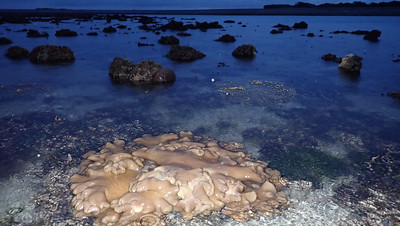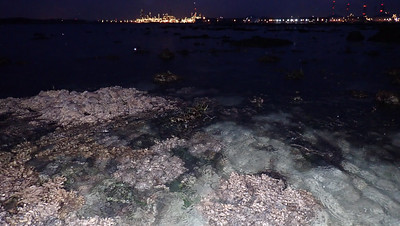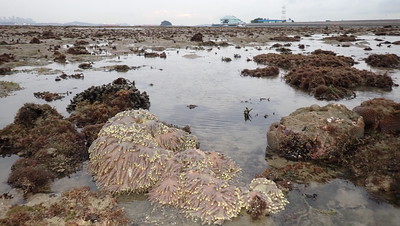Despite the drizzle and short working window in the dark, we find happy corals and many Magnificent anemones. The seagrass situation seems unchanged and we continue to hope for the best.
The most eye-poking animals on the shore remain the Magnificent anemones. These anemones form clumps of many individuals, apparently through division. So those with similar body colours are probably closely related. As usual, there were bright red, bright purple and white body colours. I also saw many Giant carpet anemones - most were okay, one was rather pale. Kelvin spotted a Pizza anemone! I couldn't find the Merten's carpet anemone though. I was delighted to see many scattered colonies of Xenia soft corals though their polyps didn't pulse much (maybe too much rain), also a colony of Ridged corallimorphs.
We encountered lots of small Black-tipped reef sharks and Blue-spotted fantail rays in the shallow waters near the reef edge. Che Cheng got a great video clip of a shark. Chay Hoon as usual spots interesting slugs and other creatures. Links to albums of photos by the team below.
 |
| Montage of photos by Chay Hoon |
In the dark and the drizzle it was hard to find and photograph the reefy edge facing Pulau Semakau. There are still many large well fomed colonies of hard corals here. Most seemed alright, I didn't see any outright bleaching, although some were rather pale.
There were a lot of Asparagus flowery soft corals, and many large leathery soft corals of various kinds. I didn't see any that were bleaching. I didn't really get to check as much as usual. The tide was fast and the drizzle made it hard to look through the water. We will be returning during more suitable conditions in June.
The seagrass situation seems not much worse but not much better. I saw similar situations in May 2023 and every annual survey since May 2019. Although heavily covered with epiphytes, there was good cover of Spoon seagrasses in many of the pools. There were many clumps of Tape seagrass with longish leaf blades especially those growing nearer the reef edge.
But the pools in the middle of the shore remain mostly bare sand. I didn't really get to survey much for seagrasses as we had to leave soon after sunrise.
There used to be lush seagrass meadows on Terumbu Semakau. Here's what the seagrass meadows looked like when we visited in June 2010. Let's hope the seagrasses will return soon!
What is the fate of Terumbu Semakau?
Terumbu Semakau lies next to the Semakau Landfill and close to the petrochemical plants on Pulau Bukom.
Terumbu Semakau and Pulau Jong will be impacted by the "Possible Future Reclamation" as outlined in the Long-Term Plan Review.
The Singapore Blue Plan 2018
Pulau Semakau and nearby islands and submerged reefs have been recommended by the Singapore Blue Plan 2018 for Immediate Conservation Priority.
The Blue Plan recommends the intertidal and subtidal marine areas of Pulau Semakau and adjacent Pulau Hantu, and Pulau Jong to be designated Marine Reserve.
The Blue Plan highlights that Pulau Semakau and its associated patch reefs comprise many ecosystems: coral reefs, mangrove areas, intertidal sandflats, seagrass meadows, and coral reefs. The subtidal area of Pulau Jong is larger than the terrestrial area. Pulau Hantu is a popular dive site has seen increasing interest in the past decade due to biodiversity awareness. If protection is accorded to these three islands, zonation plans for use can be implemented to manage tourism and human impacts.
DOWNLOAD the Plan, SUPPORT the Plan! More on the Singapore Blue Plan 2018 site.
Photos by others of this survey
Liz Lim
Chay Hoon
Kelvin Yong
Che Cheng Neo
Tommy Tan











